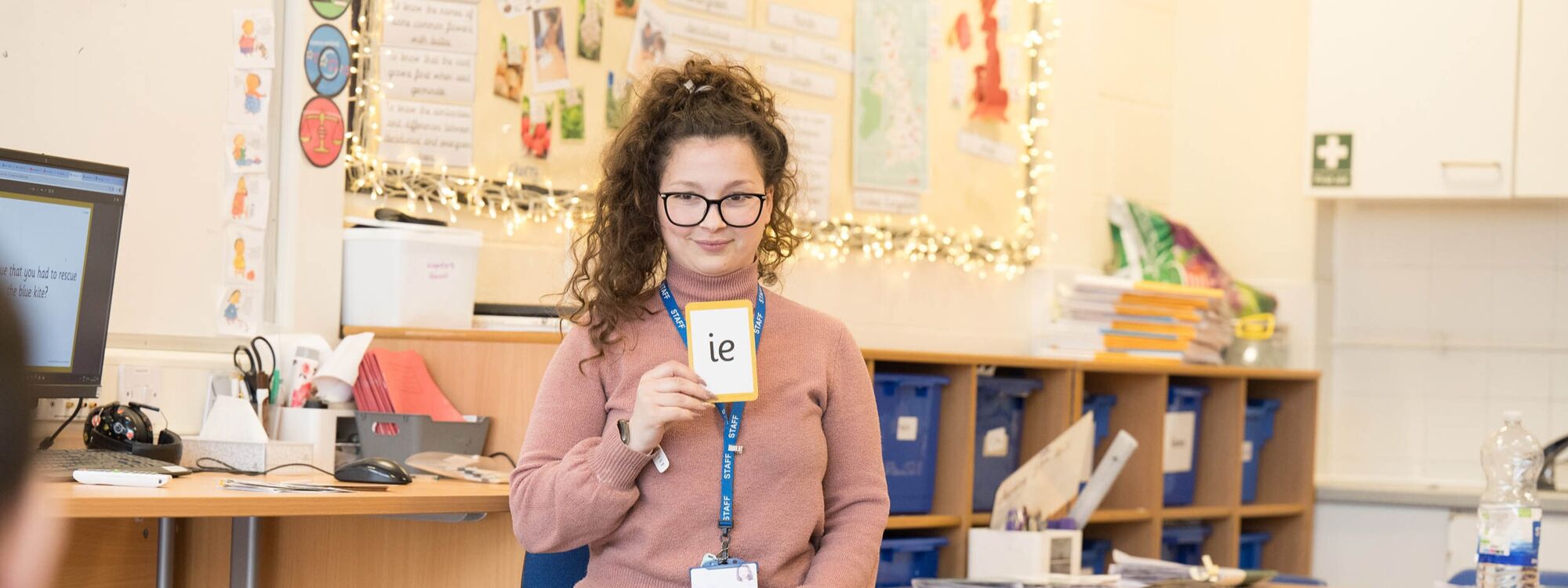- Home
- Our Curriculum
- Subject Areas
- Phonics and early reading
Phonics and early reading
We believe that all our children can become fluent readers and writers, whatever their starting point. We start teaching phonics in Nursery and use the fully accessible, DfE accredited programme, ‘Little Wandle Letters and Sounds Revised’.
Children build on their growing knowledge of the alphabetic code, learning and mastering phonics to enable them to read and spell as they move through school. As a result, all our children are able to tackle any unfamiliar words as they read.
We model the application of the alphabetic code across the curriculum. We have a strong focus on language development for all our children, because we know that confident reading, listening and speaking skills are crucial for reading and writing in all subjects.
By the time children leave us, they read confidently and enjoy reading for pleasure. They are equipped with the tools to tackle unfamiliar vocabulary and we encourage our children to see themselves as readers and writers for both pleasure and purpose.
Because we believe that reading is a vital life skill and the key to all learning, we have a Reading Leader who drives the early reading programme in our school. This person is highly skilled at teaching phonics and reading, and they monitor and support our early reading team, so everyone teaches with fidelity to the Little Wandle Letters and Sounds Revised programme.
Find out more about Little Wandle
https://www.littlewandlelettersandsounds.org.uk
Here are some of the terms we use in class:
-
Phoneme - the smallest unit of sound in a word.
-
grapheme – letter or a group of letters representing one sound, e.g. s, sh, ch, igh.
-
digraph – two letters making one sound, e.g. sh, th, ph.
-
vowel digraphs – two vowels which, together, make one sound, e.g. ai, oo, ow.
-
split digraph – two letters, split, making one sound, e.g. a-e, as in make or i-e in kite
-
VC word: vowel consonant e.g. up
-
CVC: consonant vowel consonant e.g. cap.
-
CCVC: consonant consonant vowel consonant e.g. clap.
-
vowels – the open sounds / letters of the alphabet: a, e, i, o and u
-
consonants – sounds/ letters of the alphabet that are not vowels.
-
blend – to merge individual sounds together to pronounce a word, e.g. s-n-a-p, blended together, reads snap.
-
Segment - to split up a word into its individual phonemes in order to spell it, e.g. the word ‘cat’ has three phonemes: /c/, /a/, /t/
How can you help at home?
-
Try to say the short sound of the letter, not the letter name. This will help children when they come to blend words together. E.g. the letter names dee-oh-gee don’t blend together to make ‘dog’
-
When you are reading to your child, emphasise the rhyming words and ask what is special about them
-
Initial letter sound hunt – Say a sound to your child and see if they can find something in their house that starts with that letter. This also works well with ‘I spy’ but remember to use the letter sound and not its name
-
Songs – Sing nursery rhymes and traditional songs with your child and talk to them about the patterns that they notice in the words
Reading
Reciprocal Reading Approach
Once children master phonics and can read fluently, we use reciprocal reading to enhance comprehension. This method emphasizes questioning, clarifying, summarizing, and predicting. In mixed-ability groups, children actively engage with texts, boosting confidence and analytical skills.
Individual Reading
All students read 1:1 with an adult regularly. This allows for personalized support, monitoring of fluency and comprehension, and discussions about reading preferences. Daily class reading, often led by students, builds confidence and expression.
Reading for Pleasure
Reading for pleasure is crucial for a child's success. We foster a love of reading through various initiatives:
-
Daily Reading: Carefully chosen books are read to children daily to expose them to diverse cultures and perspectives.
-
Inviting Book Corners: Every classroom has a book corner.
-
Reading Diaries: From Reception, children and parents use diaries to communicate about reading experiences.
-
Library Visits: Classes visit the local library and participate in events like the Summer Reading Challenge.
-
School Libraries: Two libraries cater to different age groups, with books selected by students to promote engagement.
-
Reading Events: Regular visits from authors, poets, and participation in book fairs enhance the reading culture.
-
Rate My Book: Displays in classrooms encourage children to rate and discuss their recent reads.
-
Reading Leaders: Key Stage 2 students promote reading through various activities and manage the library spaces.
-
Imagination Library: In partnership with the Dollywood Foundation, children up to age five receive monthly books to inspire early reading.
Helping at Home
-
Listen to your child read daily, even if they are fluent.
-
Discuss the books they read, asking about characters, plot predictions, and their enjoyment.
-
Visit the local library together to explore new books.
By integrating these practices, Victoria Primary School aims to cultivate a lifelong love of reading and ensure each child achieves reading success.
